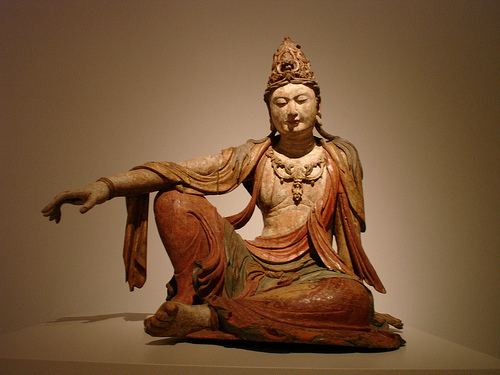Chinese 布袋 Wade–Giles Pu-tai Hokkien POJ Pò͘-tē | Hanyu Pinyin Jyutping bou3 doi6 Chinese 笑佛 | |
 | ||
Budai or Pu-Tai (Chinese and Japanese: 布袋; pinyin: Bùdài; rōmaji: Hotei; Vietnamese: Bố Đại) is a Chinese folkloric deity. His name means "Cloth Sack", and comes from the bag that he is conventionally depicted as carrying. He is usually identified with or seen as an incarnation of Maitreya, the future Buddha, so much so that the Budai image is one of the main forms in which Maitreya is depicted in China. He is almost always shown smiling or laughing, hence his nickname in Chinese, the Laughing Buddha (Chinese: 笑佛; pinyin: Xiào Fó). In the West, the image of Budai is often mistaken for that of Gautama Buddha, and is hence called the Fat Buddha (Chinese: 胖佛; pinyin: Pàng Fó).
Contents
Description
Budai is traditionally depicted as a fat, bald man wearing a robe and wearing or otherwise carrying prayer beads. He carries his few possessions in a cloth sack, being poor but content. He is often depicted entertaining or being followed by adoring children. His figure appears throughout Chinese culture as a representation of contentment.
History
According to Chinese history, Budai was an eccentric Chan monk (Chinese: 禅; pinyin: chán) who lived in China during the Later Liang (907–923). He was a native of Zhejiang and his Buddhist name was Qieci (Chinese: 契此; pinyin: qiècǐ; literally: "Promise this"). He was considered a man of good and loving character.
Buddhism
Some Buddhist traditions consider him a Buddha or a bodhisattva, often identifying him with Maitreya (the future Buddha).
His identification with the Maitreya is attributed to a Buddhist hymn (Chinese: 偈语; pinyin: jìyǔ) he uttered before his death:
彌勒真彌勒,化身千百億,時時示世人,時人自不識Folklore
Budai in folklore is admired for his happiness, plenitude, and wisdom of contentment. One belief popular in folklore maintains that rubbing his belly brings wealth, good luck, and prosperity.
In Japan, Hotei persists in folklore as one of the Seven Lucky Gods (Shichi Fukujin).
Yiguandao
Statues of Budai form a central part of Yiguandao shrines, where he is usually referred to by the Sanskrit name Maitreya. According to Yiguandao, he represents many teachings, including contentment, generosity, wisdom and open kindheartedness. He is predicted to succeed Gautama Buddha as the next Buddha, and helps people realize the essence within, which connects with all beings.
Chan, Seon and Zen
The primary story that concerns Budai in Chan Buddhism, (Korean: Seon, Japanese: Zen) is a short kōan. In it, Budai is said to travel giving candy to poor children, only asking a penny from monks or lay practitioners he meets. One day a monk walks up to him and asks, "What is the meaning of Chan?" Budai drops his bag. "How does one realize Chan?" Budai then takes up his bag and continues on his way.
Many versions of the Ten Bulls feature Hotei in the tenth picture.
Angida Arhat
Angida was one of the original Eighteen Arhats. According to legend, Angida was a talented Indian snake catcher whose aim was to catch venomous snakes to prevent them from biting passers-by. Angida would also remove the snake's venomous fangs and release them. Due to his kindness, he was able to attain bodhi.
In Chinese art, Angida is sometimes portrayed as Budai, being rotund, laughing, and carrying a bag.
Phra Sangkajai / Phra Sangkachai
In Thailand, Budai is sometimes confused with another similar monk widely respected in Thailand, Phra Sangkajai or Sangkachai (Thai: พระสังกัจจายน์). Phra Sangkajai (Thai: มหากัจจายนเถระ), a Thai rendering of Kaccayana, was an arhat during the time of the Buddha. Buddha praised Phra Sangkachai for his excellence in explaining sophisticated dharma (or dhamma) in an easily and correctly understandable manner. Phra Sangkajai (Maha Kaccana) also composed the Madhupinadika Sutra (Madhupindika Sutta MN 18).
One tale of the Thai folklore relates that he was so handsome that once even a man wanted him for a wife. To avoid a similar situation, Phra Sangkadchai decided to transform himself into a fat monk. Another tale says he was so attractive that angels and men often compared him with the Buddha. He considered this inappropriate, so disguised himself in an unpleasantly fat body.
Although both Budai and Phra Sangkachai may be found in both Thai and Chinese temples, Phra Sangkachai is found more often in Thai temples, and Budai in Chinese temples. Two points to distinguish them from one another are:
- Phra Sangkajai has a trace of hair on his head (looking similar to the Buddha's) while Budai is clearly bald.
- Phra Sangkajai wears the robes in Theravada fashion, with the robes folded across one shoulder, leaving the other uncovered. Budai wears the robes in Chinese style, covering both arms but leaving the front part of the upper body uncovered.
In popular culture
Benihana's famous figural "tiki mugs" for exotic cocktails, the most common of which depicts Hotei, have become collectible.
